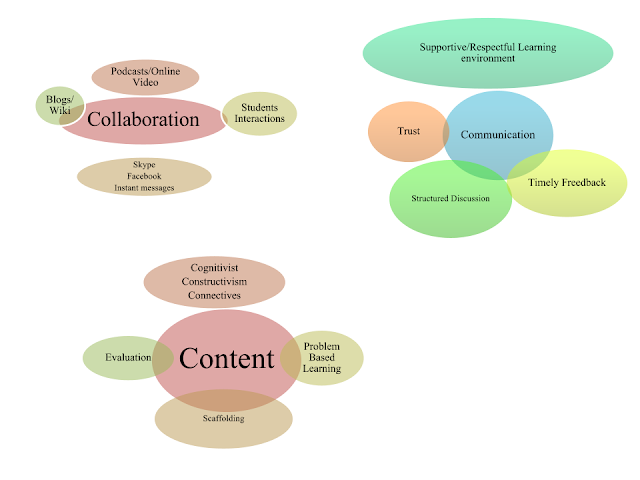Educational Technology
Monday, August 20, 2012
Sunday, August 12, 2012
Concept Map for Technology and Media for Distance Education
In teaching and developing
online courses, there are many technologies that can be used to facilitate
learning. Moller (2008) suggested that as an instructor or instructional
designer makes decisions regarding the technology to use in order to support
knowledge building and to achieve specific learning outcomes. For example, if
an instructor selects a static technology, little is performed in assisting a
learner to build on his/her knowledge. Instead, static technologies provide
learners with the opportunity to capture information. Further, static
technologies are popular because they copy the face-to-face classroom or
teacher-led instruction. Based on these findings, I have concluded that I am in
the middle of the continuum. Through the continuous use of wikis, blogs,
discussion boards, chats, and other similar and new technological approaches at
Walden University, I will be moving closer towards the dynamic end of the
interactivity that includes: a) virtual simulations and gaming, b) multi-user
environments, and c) mind tools. These technologies will assist me in
developing a precise, clearer, and deeper cognitive level. Further, mind tools
are computer applications that, when used by learners to represent what they
know, which in turn engage them in critical thinking about the content they are
studying (Jonassen, 1996). For instance, using databases to organize students’
understanding of content organization necessarily engages them in analytical
reasoning, where creating an expert system rule base requires them to think
about the causal relationships between ideas. Therefore, students cannot use mind
tools as learning strategies without thinking deeply about what they are
studying.
References
Jonassen, D.H., Carr, C.,
& Yueh, H. (1998). Computers as mindtools for engaging learners in critical
thinking. TechTrends. 43(2), 24-32.
Moller, L. (2008). Static
and dynamic technologies. Unpublished. Laureate Education, Inc. Retrieved from http://sylvan.ecollege.com/ec/courses/14936/CRS-WUEDUC8812-3730064/8842_MS_Paper.pdf.
Sunday, July 29, 2012
Reflection of Graphic Organizer
Reflection of Graphic Organizer
Technological tools available today allow facilitators and learners to enhance the learning environment with differentiated instruction characterized by interactivity engagement. Widely adopted innovations such as email and instant messaging equip users with the ability to communicate and collaborate at real time speed. These adoptions are considered norms in any workplace setting and still are seen as relevant. Another innovation becoming more prominent in school environments are the use of podcasts and online video for classroom facilitation and professional development for instructors. These tools allow individuals to access information at their convenience.
In addition, these tools equip users with the ability to pause and replay when clarification is needed. Also, user-generated tools such as blogs and wikis allow users to present information and perspectives in a manner that is individualized and useful. Bringing these tools into classrooms (online or traditional) will allow users to access a wealth of insight and knowledge on designated topics and aid in collaborative efforts facilitated by instructors. In addition, social networking innovations such as Skype allow users to chat, SMS, call, or video call peers or cohort members to network, discuss, and collaborate regarding project based learning assignments and discussions. This innovation is useful to classroom (online and traditional) because it allows users to participate in collaborative activities with global users.
Thursday, July 12, 2012
Assessing Collaborative Efforts
Assessing Collaborative Efforts
How should participation in a collaborative learning
community be assessed? How do the varying levels of skill and knowledge
students bring to a course affect the instructor’s “fair and equitable
assessment” of learning?
In most
collaborative learning communities it’s imperative that the individuals know
how they are being assessed. According to Dr. Siemens, “the assessment has to
be changed in order for it to work”. He also states, “That there must be a way
for individual to stand out” (Siemens, 2008). He states that “blogging can help
contribute to the learning community” (Siemens, 2008). This is stated because
it gives the individual a change to express their opinions and still
participate with the community” (Siemens, 2008). I totally agree with Dr. Siemens on all his
opinions. There is a way for all individuals to stand out even though they are
being graded with a group. Active and progressive learning will not occur if
the student cannot function with the group.
If a student does not want to network or collaborate in a
leaning community for an online course, what should the other member of the
learning community do? What role should the instructor play? What impact would
this have on his or her assessment plan?
Some
students don’t like to participate with group assignments. If a student does
not want to participate with the group the educator should find way for that
student to participate without making them feel uncomfortable. Feedback is
always good for students to receive. The group members should also provide
feedback to the instructor on how they feel about various issues. This change
can sometimes assessment plans can give a level of comfort. Students who like
working alone should receive the same equal treatment and assessment that their
classmate receives.
Reference:
Siemens,
G. (2008). Learning Communities. Laureate Education
Siemens,
G. (2008). Assessment of Collaborative Learning, Laureate Education
Subscribe to:
Comments (Atom)

